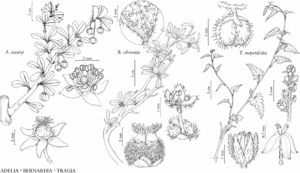Difference between revisions of "Tragia nepetifolia"
Icon. 6: 37, plate 557, fig. 1. 1800.
FNA>Volume Importer |
FNA>Volume Importer |
||
| Line 29: | Line 29: | ||
|distribution=Ariz.;Colo.;N.Mex.;Mexico;Central America. | |distribution=Ariz.;Colo.;N.Mex.;Mexico;Central America. | ||
|discussion=<p><i>Tragia nepetifolia</i> is typically found at high elevations in Mexico and the southwestern United States. Since it was described more than 200 years ago, many collections of <i>Tragia</i> in Mexico and the United States have been identified mistakenly as this species.</p><!-- | |discussion=<p><i>Tragia nepetifolia</i> is typically found at high elevations in Mexico and the southwestern United States. Since it was described more than 200 years ago, many collections of <i>Tragia</i> in Mexico and the United States have been identified mistakenly as this species.</p><!-- | ||
| − | --><p><i>Tragia nepetifolia</i> includes four varieties in Mexico, but none match plants occurring in the United States. These most closely resemble <i></i>var.<i> dissecta</i> Müller Arg. of western Mexico, sharing inflorescences with distally clustered staminate flowers and a tendency toward reddish coloration, but differing in that their leaf blades are not as deeply toothed.</p> | + | --><p><i>Tragia nepetifolia</i> includes four varieties in Mexico, but none match plants occurring in the United States. These most closely resemble <i></i></i>var.<i><i> dissecta</i> Müller Arg. of western Mexico, sharing inflorescences with distally clustered staminate flowers and a tendency toward reddish coloration, but differing in that their leaf blades are not as deeply toothed.</p> |
|tables= | |tables= | ||
|references= | |references= | ||
| Line 53: | Line 53: | ||
|publication year=1800 | |publication year=1800 | ||
|special status=Selected by author to be illustrated | |special status=Selected by author to be illustrated | ||
| − | |source xml=https://jpend@bitbucket.org/aafc-mbb/fna-data-curation.git/src/ | + | |source xml=https://jpend@bitbucket.org/aafc-mbb/fna-data-curation.git/src/f6b125a955440c0872999024f038d74684f65921/coarse_grained_fna_xml/V12/V12_486.xml |
|genus=Tragia | |genus=Tragia | ||
|species=Tragia nepetifolia | |species=Tragia nepetifolia | ||
Revision as of 18:18, 24 September 2019
Subshrubs, 1.5–5 dm. Stems erect to trailing, green to reddish green, apex never flexuous. Leaves: petiole 3–25(–41) mm; blade triangular to ovate [linear], proximal broadly ovate to sometimes suborbiculate, 1.8–5 × 0.9–3.6 cm, often red-green, base truncate to cordate, margins coarsely dentate to coarsely serrate, apex acute. Inflorescences terminal (often appearing leaf opposed), glands sessile or absent, staminate flowers 8–40 per raceme, distally clustered [evenly distributed]; staminate bracts 1.3–1.6 mm. Pedicels: staminate 1.4–1.7 mm, persistent base 0.5–0.7 mm; pistillate 2.9–3.3 mm in fruit. Staminate flowers: sepals 3–4, reddish green, 1–2 mm; stamens 3–4, filaments 0.3–0.6 mm. Pistillate flowers: sepals lanceolate [ovate], 1.4–2.3 mm; styles connate 1/4–1/3 length; stigmas papillate. Capsules 6–8 mm wide. Seeds brownish black, 3–4 mm.
Phenology: Flowering late spring; fruiting late summer–fall.
Habitat: Pine-oak woodlands.
Elevation: 1500–2500 m.
Distribution
Ariz., Colo., N.Mex., Mexico, Central America.
Discussion
Tragia nepetifolia is typically found at high elevations in Mexico and the southwestern United States. Since it was described more than 200 years ago, many collections of Tragia in Mexico and the United States have been identified mistakenly as this species.
Tragia nepetifolia includes four varieties in Mexico, but none match plants occurring in the United States. These most closely resemble var. dissecta Müller Arg. of western Mexico, sharing inflorescences with distally clustered staminate flowers and a tendency toward reddish coloration, but differing in that their leaf blades are not as deeply toothed.
Selected References
None.
